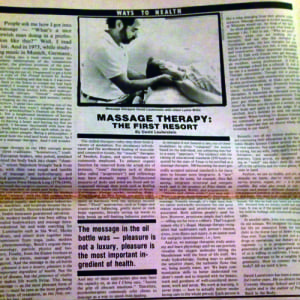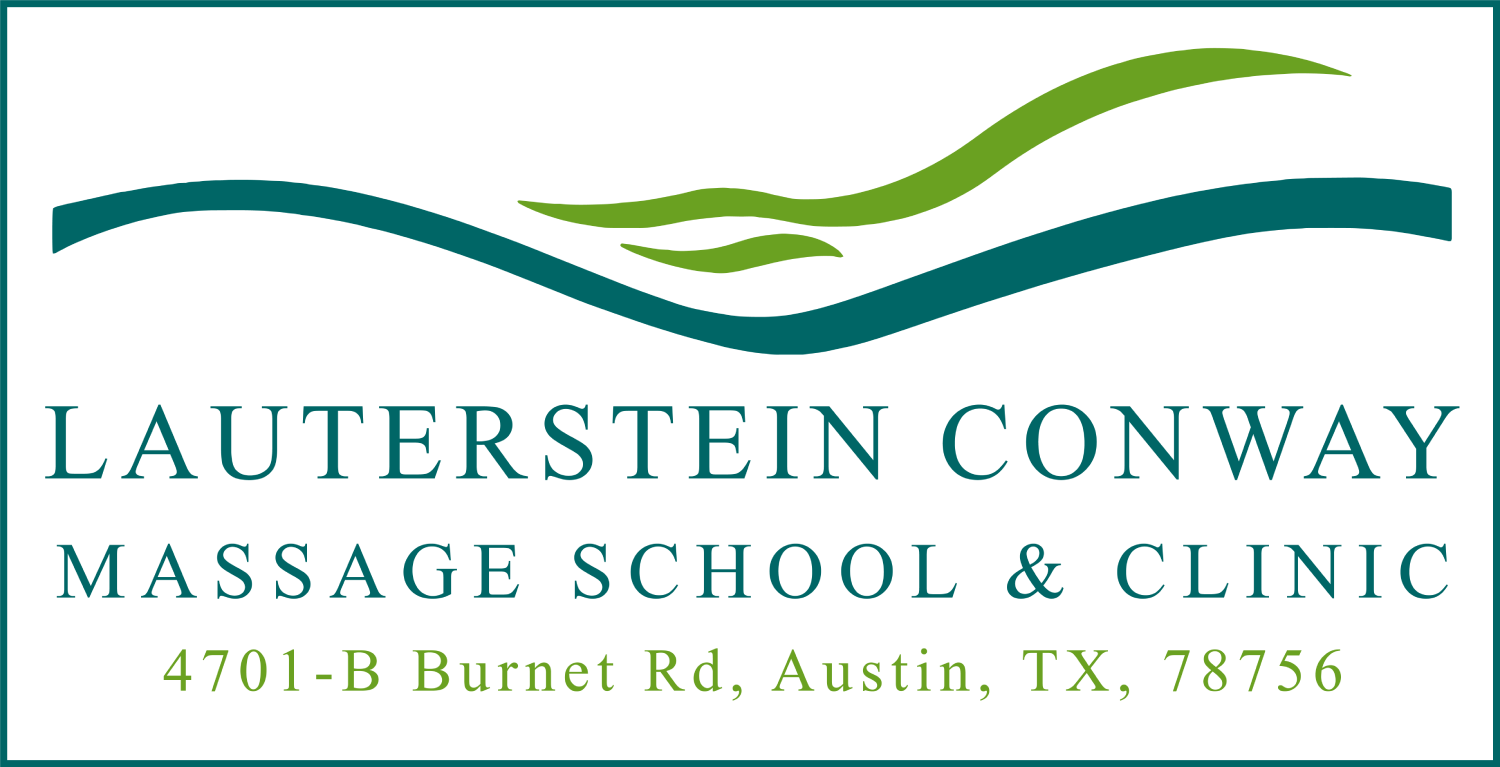 (taken from a 1989 issue of the Austin Chronicle – slightly updated)
(taken from a 1989 issue of the Austin Chronicle – slightly updated)
by David Lauterstein
People ask me how I got into massage – “What’s a nice Jewish man doing in a profession like this?” Well, I read a lot. And in 1973, while studying music in Munich, Germany, and falling into a funk which neither the aesthetic ministrations of my composition teacher, the glorious promises of the post-sixties cultural revolution, nor German beer could bring me out of, I happened to get a hold if a copy of The Primal Scream by Arthur Janov. One reading and that was it. I was coming back to the States to scream my way back to sanity! I wound up in Chicago, studying kung fu, teaching autistic kids, and undergoing Gestalt therapy. “Gestalt” emphasizes presents feelings, thoughts and actions, rather than digging up the past.
Anyhow, I spent two years getting out of the funk, and the key wasn’t insights about my mother’s grandmother’s fixation on Peter the Great but a heightened awareness of having feelings and a body, a compassionate attachment to having a heart and having my feet on this earth. I became fascinated with how the mind, body and heart affect each other, in myself and in other people. Being a philosopher, I wondered how the soul and body connect. So I became a massage therapist. And I still wonder.
Massage therapy in the 19th century arose out of three traditions: “bonesetters,” traditional European healers, who poked, prodded and twisted the body back into shape; “Shampooers,” whom Napoleon brought back from Turkey, with their own rough and tumble brand of massage and hydrotherapy; and “medical gymnasts,” descendants of Swedish fencing master Peter Heinrik Ling (1776-1839), who stressed the curative powers of movement and “the one-ness of mind and body.”
The one-ness was rent asunder by modern medical “science” with the 20th century backing of the unholy trinity – the pharmaceutical, hospital supply, and insurance industries. Drugs, machines, and hospitals became the instruments of health. Doctors headed the priesthood, heath insurance guaranteed salvation.
While modern medicine was busy selling its soul, exiled bodyworkers and massage therapists wandered far and wide searching for theirs. Luminaries such as Ida Rolf, Moshe Feldenkrais, and others drew together idea and experiences from yoga, judo, modern dance, phenomenology, Reich’s orgone therapy, neurology, particle physics and biochemistry. Finally, from the Esalen Institute in Big Sur, California in the sixties, massage re-emerged, transfigured. And the message in the oil bottle was – pleasure is not a luxury – pleasure is perhaps the most important ingredient in health. Not the absence of disease, but the presence of vitality is what makes life worth living. This being true, massage – as the most pleasant form of medicine – must be seen as the most generally necessary form of treatment, as the first, certainly not the last resort.
The skilled therapists of today may draw from a variety of modalities. For circulatory refreshment and the accelerated healing of muscular and connective tissues, the “muscle” therapists of Swedish, Esalen and sports massage are commonly employed. To enhance organic function far removed from the actual site of pressure, “zone” therapies such as shiatsu (also called “acupressure”) and reflexology may have dramatic impact. Dysfunctional postures of body and mind are freed and reorganized though deep work such as Rolfing or movement works like Feldenkrais or Aston-Pattering. Energy works, including Reiki, Polarity, and Jin Shin Jyutsu, use gentle touch to “tune” bodily energy flows towards being more in harmony with the universe around them. “Fluid” approaches, such as Trager and Cranio-sacral balancing, gently move or rock body segments, literally setting up waves to help break up self-limiting behavior patterns. Deep Massage and Zero Balancing aim at freeing and aligning both the body’s structure and energy. And any of these approaches also may have the capacity to, as the I Ching says, “loosen the grip of obscure emotions.” Therefore, psychotherapists commonly refer clients to massage as a way to speed their healing.
A therapist is not limited to any one of these modalities; he often “composes” the session based on the individual, not subjecting him/her to a static “approach.” The tendency with the raising of educational standards is for therapists to become more integrative.
“Names and claims aside,” you may ask, “What’s so great about massage?” and frankly I believe its love that’s so great about massage. Funnily enough, its right here that we rather awkwardly encounter the one good reason massage and prostitution were ever associated. Both address people’s needs for love. However, prostitutes simply don’t deliver – selling sex for love is robbery. That’s a good reason why it’s illegal. Massage therapy recognizes that underneath each person’s tension, stress, even illness and injury, is an unmet need for energetic nourishment, i.e. love.
And so, we massage therapists study anatomy and learn physiology until we can precisely visualize the oxygen molecules hitting the bloodstream with the force of life itself. We study hydrotherapy, finding ways to address the sensitive chaos, the turbulent flows that we, being mostly water, are. We learn communication skills to better understand our clients’ needs and to respond with the beauty, truth and goodness of well-considered movement, work and intent. We work at learning, it never stops – how to actually deliver tender loving care to the whole person. Each person is like a song emerging from their genetic code/notation. Massage therapy at its best amplifies, as Whitman would say, the Song of the Self.
So, when people call me to ask what kinds of massage I do, I like to ask, “Who are you?” If you’re “Bob”, I do Bob therapy. Similarly, when you are looking for a therapist, find out who this therapist is. Techniques aside, the best therapist for you will be a person who you feel is truly caring and trustworthy. Other important considerations: 1) Talk with friends who get massage. Word of mouth is often the best bet for finding an excellent, caring professional. 2) Call a local massage school for a referral. 3) Ask is he/she is a member if the American Massage Therapy Association or the Association of Bodywork and Massage Professionals . Though not a guarantee of excellence, such membership usually indicates professionalism. 4) Make sure he/she is licensed with the state. (fourteen states had licenses in 1989 – now forty-seven states license massage therapists.) 5) Interview the therapist over the phone before you make an appointment. Trust your gut feelings. Does this person really listen? 6) When you receive a session, trust your body and spirit to be the judge. Don’t hesitate to give the therapist even mid-session, helpful feedback regarding pressure, pain, etc.. If unsatisfied, don’t hesitate to seek out another therapist. When looking for disease treatment, we commonly get a second opinions and it is equally important that we choose wisely when investing in our health.
Recently, two of my former students who are continuing their educations at the San Antonio Health Science Center invited me down to view cadavers. Not your usual Sunday family outing, but my wife, Julie, and I, both being therapists, are naturally fascinated with anatomy. Upon arrival, my daughter, Katja, declaring us “weird” (we didn’t deny it), marched off to the cafeteria and the video games, Walkman in hand.
Anyhow, we saw six bodies, and yes, all the muscles we know, they’re there, and the nerves, arteries, organs, etc. – it is just incredible. But what also struck us was how strongly each person’s different character was still expressed somehow in the contour of muscle and bone. The dead body really is “all she wrote.” One man thickly muscled, and large boned, felt like he had just born up under his life. Around him we simply could not concentrate. It was as if the power and confusion of his held-in feelings still ricocheted around the table.
At another table, Julie was smiling over a little old woman. We imagined the sweetness of her life yet emanated from her form. And there in the literal face of death it was clearer than ever. True health is not just a matter of drugs or operations, nor dietary or calisthenic regimens – it is proportional to the true generosity of spirit in love and work that each of us is willing to cultivate. I hope and intend massage therapy to be tangible form of this generosity. How to connect the soul and the body? All we need is love.
David Lauterstein has been a massage therapist now for forty years. He co-directs the Lauterstein-Conway Massage School and Clinic (TLC) in Austin and is the author of two books, Putting the Soul Back into the Body and The Deep Massage Book – How to Combine Structure and Energy in Bodywork.
